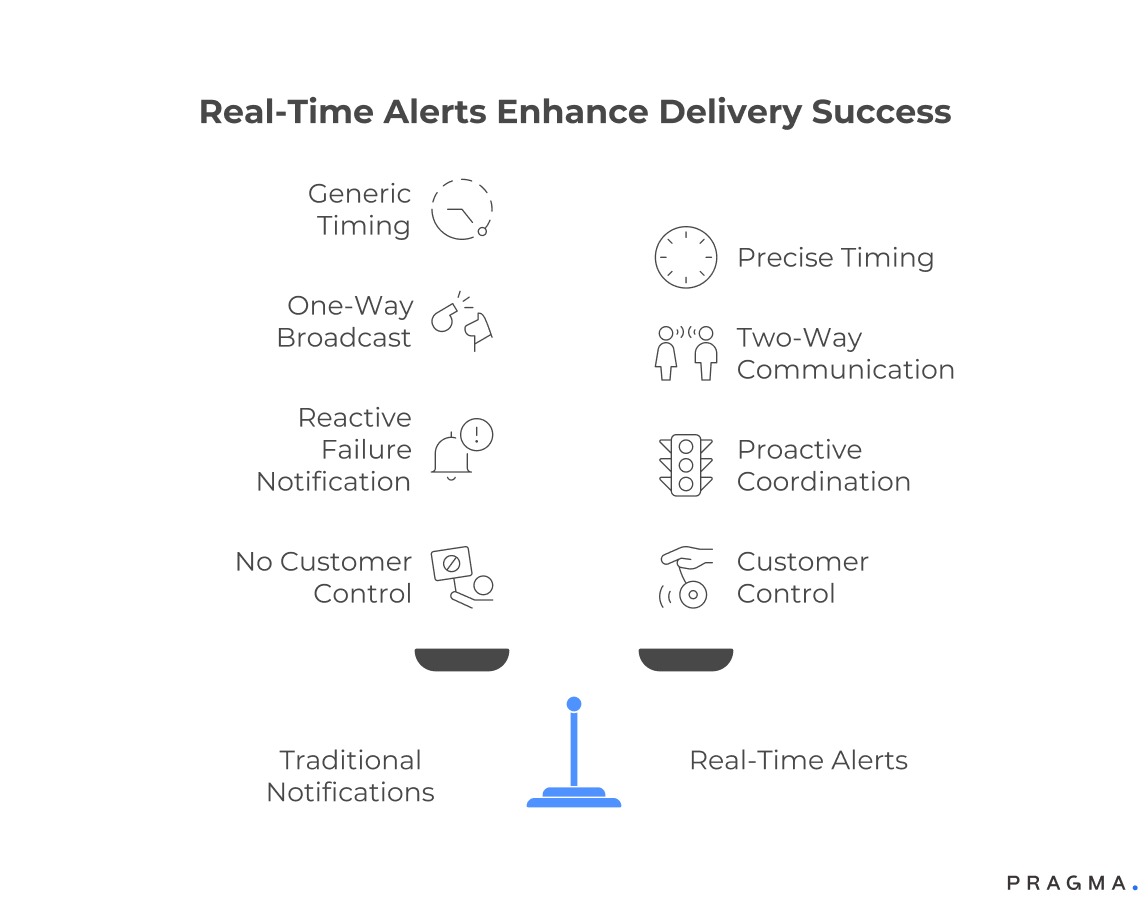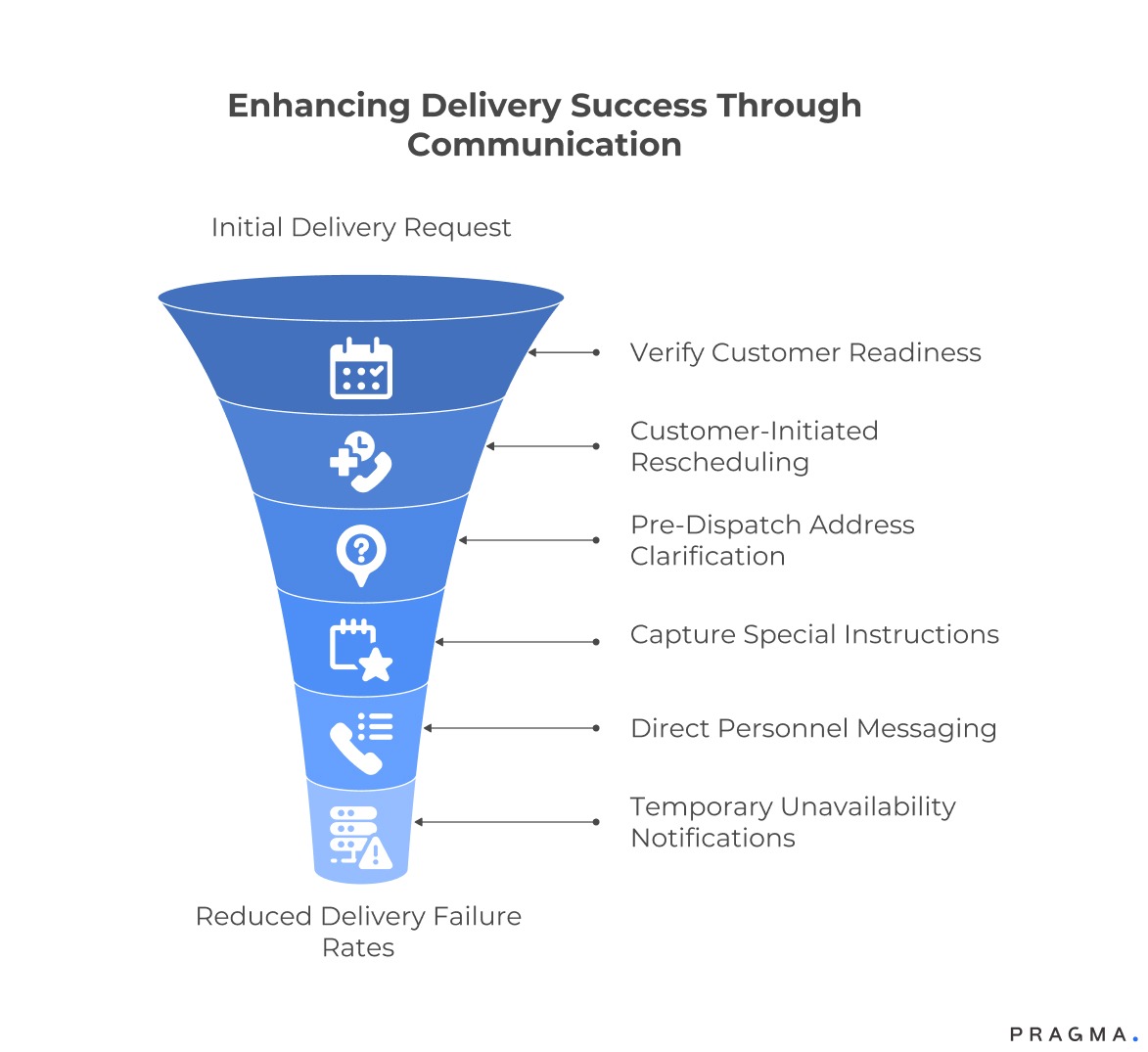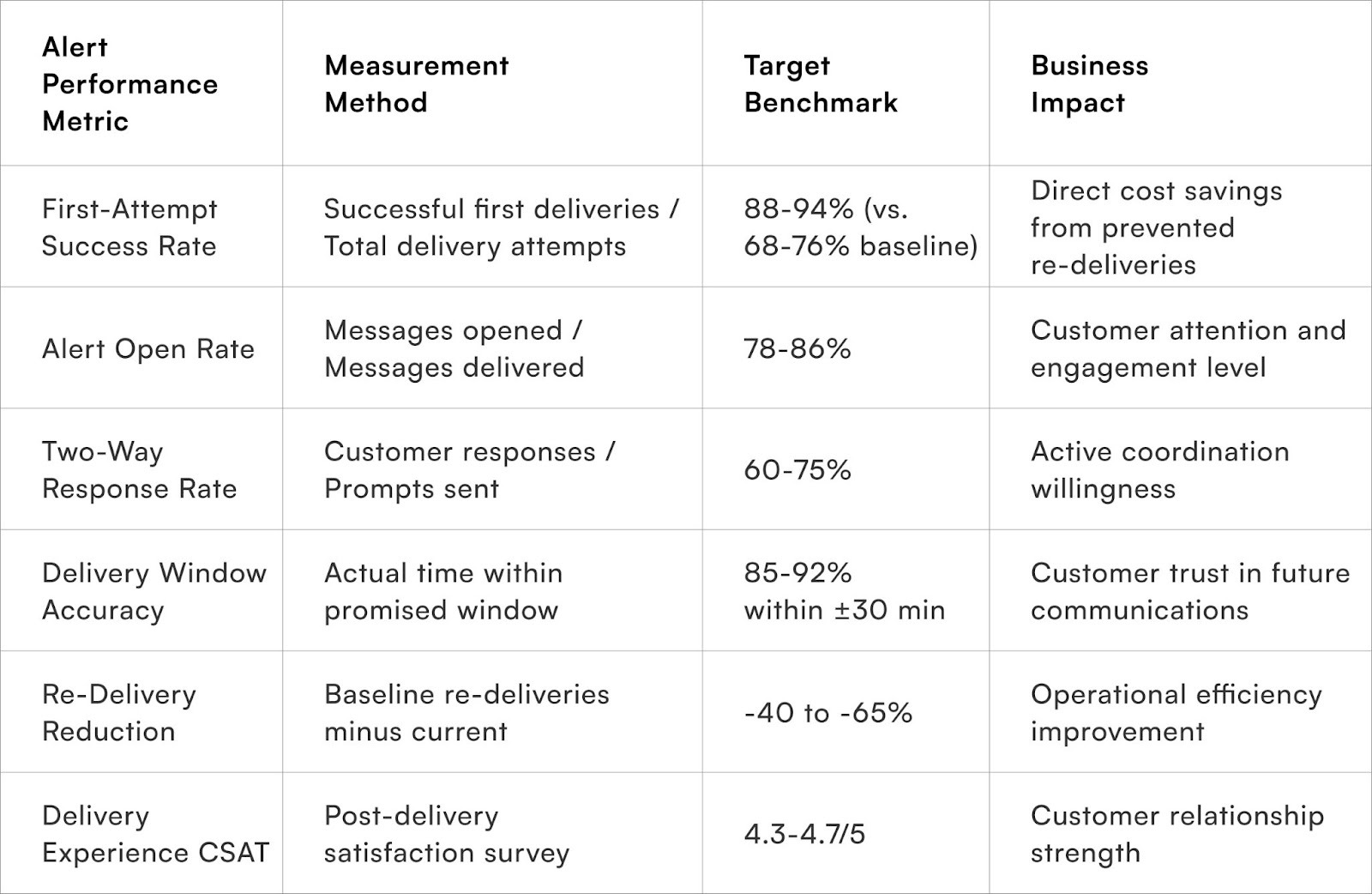Real-time alerts play a pivotal role in preventing failed deliveries and reducing Return to Origin (RTO) rates, especially in the complex Indian e-commerce ecosystem. By providing instant notifications to customers via SMS, WhatsApp, and email at every stage of the delivery journey, brands keep buyers informed, engaged, and empowered to act—whether to reschedule delivery, update incorrect address details, or confirm availability.
These automated alerts help reduce missed deliveries and cancellations by proactively resolving issues that typically result in costly returns.
Leading Indian players like Fship and Pragma leverage real-time tracking and Non-Delivery Report (NDR) automation to achieve up to 20% reductions in RTO rates. Intelligent tools identify delivery failures immediately, trigger customer follow-ups, and enable quick resolution through rescheduling or order modifications.
Coupled with
- smart COD confirmation flows
- AI-driven risk profiling
- and optimal courier selection
real-time alerts create a seamless logistics experience that translates into higher first-attempt delivery success, happier customers, and improved profitability.
In summary, implementing real-time alert systems is no longer optional but essential for Indian D2C brands aiming to scale efficiently while maintaining customer trust. This approach not only addresses operational inefficiencies but also transforms logistics into a strategic growth lever in the highly competitive e-commerce market.
This comprehensive guide on The Role of Real-Time Alerts in Preventing Failed Deliveries draws on recent Indian market examples and data-backed best practices to guide D2C brands in building smarter, customer-friendly delivery operations.
Why do traditional delivery notifications fail to prevent delivery failures?
Generic status updates miss the critical timing and actionable information needed for customer coordination
Core Problems with Conventional Notifications:

- Timing Misalignment and Uncertainty:
Sending an "out for delivery" notification early (e.g., 8-9 AM) with a delivery window spanning 8-10 hours (e.g., 11 AM - 7 PM) is practically useless for customer planning, as people cannot wait indefinitely.
- Lack of Specific Delivery Windows:
Generic "your order will arrive today" messages fail to enable coordination. Customers require a narrow 2-3 hour window, such as "delivery expected between 2-4 PM," to arrange availability or coordinate package receipt.
- Missing Actionable Resolution Paths:
When a delivery attempt fails, notifications often omit instructions on how customers can reschedule, provide an alternative address, or arrange a workplace delivery. This information gap frustrates customers and frequently leads to cancellations instead of successful re-delivery.
- Surprise Deliveries (Silent Approach):
Delivery personnel often arrive unannounced, finding customers momentarily unavailable (e.g., in the bathroom, on a call, or briefly away). A simple 5-10 minute advance alert (via SMS or call) would allow customers to prepare, significantly boosting success rates.
- Delayed Detection of Incorrect Contact Info:
Address problems or unreachable phone numbers are typically only discovered after a carrier marks the delivery as failed. This misses crucial opportunities to correct details before or during transit when action is still possible.
- One-Way Communication:
Traditional SMS or email broadcasts do not allow for customer dialogue. Essential customer input, such as questions about timing, specific instructions for the carrier, or temporary unavailability alerts, cannot be communicated back through these channels.
Demonstrated Inadequacy:
Personal care brands in Bangalore, for example, previously achieved only a 73% first-attempt success rate using standard "order dispatched" and "out for delivery" messages.
Analysis showed that the 27% failure rate included cases where customers were home but missed the doorbell, were briefly away during the actual arrival, or where a simple address clarification could have ensured success had it been proactively communicated.
What specific alert types generate measurable failure prevention?
Progressive notification sequences with narrowing timeframes enable customer preparation at each stage
Optimising Delivery Success with a Layered Real-Time Alert Strategy
Effective delivery management relies on strategically sequenced real-time alerts that progressively reduce uncertainty and provide customers with sufficient notice to act. Different alert types serve critical functions at various points in the delivery lifecycle:
1. Advance Planning (Evening-Before Alerts):
- Purpose: Establish next-day delivery expectations and an approximate time window.
- Actionability: Sent 18-24 hours in advance (e.g., 6-8 PM, "Your order will be delivered tomorrow between 2-5 PM"), these alerts allow customers to plan their availability, arrange for remote work, or coordinate with others for package receipt.
2. Refined Confirmation (Morning-Of Updates):
- Purpose: Narrow the delivery window based on actual route planning.
- Actionability: Sent once carrier routes are finalized (e.g., 10-11 AM, "Delivery expected between 2-4 PM today"), these updates provide a more accurate 2-3 hour timeframe based on the driver's route position.
3. Critical Intervention (Imminent Arrival Alerts):
- Purpose: Prompt immediate customer preparation just before arrival.
- Impact: Sent when the delivery person is at a neighboring stop (typically 15-20 minutes away, e.g., "Your delivery executive is 5-10 minutes away—please be available"). These proximate warnings significantly boost customer readiness from an estimated 68-74% to 94-97%.
4. Enhanced Transparency (Live Location Sharing):
- Purpose: Offer minute-by-minute visibility for premium or high-value shipments.
- Value: This allows customers who are actively anticipating the delivery to track progress and ensure precise coordination.
5. Proactive Error Prevention (Address Verification Alerts):
- Purpose: Catch and correct address issues before dispatch.
- Efficiency: By proactively reaching out for clarification when details are incomplete or incorrect before carrier pickup, companies prevent wasted delivery attempts, making corrections far more efficient than post-failure fixes.
6. Quick Recovery (Failed Attempt Immediate Notification and Rescheduling):
- Purpose: Prevent cancellations and ensure quick resolution when the first attempt fails.
- Mechanism: Instant notification with easy one-click rescheduling options prevents orders from stalling in a "failed delivery" status while the customer remains unaware.
Case Study: Hyderabad Electronics Brands
A five-stage alerting system implemented by Hyderabad electronics brands—covering evening-before (3-hour window), morning-of (refined 2-hour window), "driver in your area" (30-minute proximity), "arriving in 5-10 minutes" final warning, and immediate failure rescheduling—demonstrates the effectiveness of this layered approach.
This progressive narrowing strategy improved their first-attempt success rate from 71% to 91%, resulting in a monthly reduction of re-delivery costs by ₹3.8 lakhs across 4,200 deliveries.
How does two-way communication capability reduce delivery failures?
Customer response mechanisms enable problem-solving before failures occur rather than after

Key strategies leveraging two-way alerts include:
1. Proactive Availability Confirmation:
Simple requests like,
"Will you be available at [address] between 2-4 PM today? Reply YES to confirm or NO to reschedule," verify customer readiness.
This approach surfaces availability problems in advance. Customers who confirm presence exhibit a 96-98% successful delivery rate, while non-responses immediately flag potential issues needing attention.
2. Customer-Initiated Rescheduling:
When customers realize they will be unavailable, easy response options (e.g., "Reply 1 for tomorrow, 2 for evening delivery, 3 to change address") facilitate efficient rescheduling.
This flexibility, initiated by the customer, prevents wasted delivery attempts more effectively than rigid scheduling.
3. Pre-Dispatch Address Clarification:
Automated outreach resolves ambiguous or incomplete addresses (e.g., missing flat numbers or vague landmarks) before dispatch.
Questions such as,
"Which tower/building at [address]?"
yield crucial responses that dramatically boost first-attempt success rates.
4. Capturing Special Delivery Instructions:
Allowing customers to add details like
- "Ring doorbell twice—sound doesn't work well,"
- "Ask security for Building C access," or
- "Call me 5 minutes before arrival"
helps address specific, location-based challenges that generic delivery processes cannot anticipate.
5. Direct Delivery Personnel Messaging:
Enabling real-time guidance between the customer and the delivery executive—such as
- "Temporarily stepped out, back in 10 minutes" or
- "Please come to back entrance, front gate locked"
facilitates immediate problem-solving during the active delivery attempt, preventing an outright failure.
6. Temporary Unavailability Notifications (Customer-Initiated):
Customers experiencing a sudden conflict can proactively message, "Please deliver after 5 PM, not available till then" or "Reschedule to tomorrow, unexpected emergency." This prevents wasted attempts and allows the carrier to optimize their route.
Demonstrated Value:
A case study involving Chennai fashion brands highlights the power of two-way communication. After implementing WhatsApp-based alerting with response options, they observed that 14% of customers proactively flagged availability issues or requested modifications before delivery attempts.
Adjustments based on these self-identified problems prevented failures. Overall, their failure rates dropped significantly, from 28% to 9%, purely due to the enhanced coordination enabled by these response mechanisms.
What technical infrastructure enables effective real-time alerting?
Carrier integration depth and customer communication platforms determine alert capability and reliability
Technical Pillars for Sophisticated Real-Time Delivery Alerts
Core Technical Components:
- Carrier API Integration (Data Foundation):
Deep integration with carrier APIs is essential for intelligent alerting. This allows for the real-time flow of critical data, including location, route sequence, and delivery attempt status, directly into the brand's platform.
Deep integrations that support location streaming are significantly more valuable than basic status update APIs, as they enable alerts based on actual progress rather than mere estimates.
- Geofencing Capabilities (Proximity Triggering):
Geofencing enables automated, location-based alerts. When a delivery executive enters a pre-defined geographic zone around the delivery address (typically a 2-5 km radius), the system automatically triggers alerts.
This technology is vital for sending the highly valued "driver nearby" notifications that prepare customers for arrival without requiring manual input from the carrier.
- Customer Communication Platform Selection (Reliability & Interactivity):
The choice of communication platform dictates the reliability and two-way capability of alerts. The WhatsApp Business API offers rich messaging, live location sharing, response buttons, and guaranteed delivery.
In contrast, SMS provides universal reach but limited interactivity. Brands should adopt a multi-channel strategy, matching message complexity and customer preference with the appropriate channel.
- Order Management System (OMS) Integration (Personalisation):
Integrating the OMS links alerts to customer data, enabling personalization.
This allows for messages to reference specific customer names, products, and addresses. It also supports intelligent alerting, such as confirming the Cash on Delivery (COD) amount or flagging high-value orders for special handling.
- Automation Workflows (Orchestration):
Rule-based automation orchestrates the entire alert sequence without manual intervention. These workflows use carrier data and time triggers to automatically send sequences like evening-before notifications, morning narrowing updates, and proximity alerts.
This ensures consistency across thousands of daily deliveries and prevents operational teams from being overwhelmed.
- Backup Communication Channels (Single-Point Failure Prevention):
To maintain reliability, backup channels are crucial.
If a primary channel like WhatsApp fails (e.g., due to customer app issues), an automatic fallback to SMS ensures that critical alerts still reach the customer through an alternative channel, preventing complete message failure.
- Analytics Infrastructure (Continuous Optimisation):
A dedicated analytics system tracks alert performance.Brands must have visibility into read rates, response rates across different message types, and the correlation between alert timing and final delivery success.
This feedback loop is essential for continuously refining messaging and timing strategies.
Example of Success:
A Pune-based home goods brand implemented a comprehensive technical stack: they integrated with three carrier APIs for real-time location data, used WhatsApp Business with SMS fallback, established geofencing for proximity alerts, and built an analytics tracking system. Despite an initial investment of ₹4.8 lakhs plus a ₹35,000 monthly operational cost, this infrastructure led to a 38% reduction in delivery failures, generating ₹6.2 lakhs in monthly savings by preventing re-deliveries and reducing Return to Origin (RTO) incidents.
How should brands measure real-time alert effectiveness?
Performance metrics must connect alert engagement to delivery outcomes rather than measuring communication in isolation
Key Metrics for Evaluating Real-Time Delivery Alert System Success
Primary Success Indicators:
- First-Attempt Delivery Success Rate: This is the most crucial metric. Brands should measure this rate both before and after implementing alerts, segmenting the data to compare customers who engaged with the alerts versus those who did not. Effective alert systems typically show an improvement of 15-25 percentage points among engaged customers.
- Re-delivery Rate Reduction: This metric quantifies the alert system's failure prevention capability. Successful proactive coordination should lead to a 40-65% reduction in re-delivery requirements. Measuring this against clear pre-implementation baselines demonstrates the operational savings achieved through the alert investment.
Metrics for System Performance and Optimisation:
- Alert Engagement Rate: This tracks the percentage of customers who open, read, and respond to notifications. A low rate (below 40-50%) points to issues with message quality, timing, or customer fatigue.
A high rate (75-85%+) signifies valuable communication that customers are actively monitoring, providing critical data for system optimisation.
- Response Rate to Two-Way Prompts: This indicates the customer's willingness to actively coordinate the delivery. A high response rate (60-75%) to prompts, such as availability confirmation requests, demonstrates customer trust in the communication channel and a readiness to participate in coordination. Low rates may signal friction or unclear value.
- Time-to-Delivery Correlation (Accuracy): This measures how well the system's estimated delivery windows align with actual delivery times.
High accuracy (within ±30 minutes) builds customer trust and alert credibility, whereas poor accuracy (±2-3 hours) actively undermines the system's value.
Customer-Focused Impact Metric:
Customer Satisfaction Specific to Delivery Experience: Isolating customer perception related to the delivery process helps determine the direct impact of the alerts. Post-delivery surveys focused specifically on communication quality and coordination effectiveness reveal whether the alert system is successfully enhancing the customer experience beyond simply preventing operational failures.

Implementing Real-Time Alerts for Failed Deliveries
Week 1: Analyse Current Delivery Failure Patterns and Root Causes
Pull 90 days of delivery data identifying all failed first attempts with failure reasons from carriers—customer unavailable, incorrect address, access issues, refused delivery, etc. Calculate failure rate by reason category, geography, and customer segment.
Interview 20-30 customers who experienced failed deliveries understanding their perspectives on what prevented success. Survey delivery personnel or carrier partners about most common preventable failure scenarios.
Expected result: Detailed understanding showing 35-50% of failures stem from coordination problems amenable to alert-based prevention, with clear priority scenarios for targeted intervention.
Week 2: Implement Evening-Before and Morning-Of Basic Alerts
Configure automated messaging sending evening-before delivery notifications (6-8 PM) with approximate timeframe ("tomorrow between 2-5 PM") and morning-of refined window updates (10 AM) with narrower ranges ("today between 2-4 PM").
Use existing SMS or WhatsApp infrastructure without requiring new integrations. Include clear address confirmation and simple instructions asking customers to confirm availability. Test with subset of 200-300 orders validating timing and message delivery.
Expected result: Immediate 8-15% improvement in first-attempt success from basic temporal coordination without sophisticated integration requirements.
Week 3: Deploy Two-Way Availability Confirmation
Add response mechanisms to morning-of alerts asking customers to confirm availability—"Will you be home between 2-4 PM? Reply YES to confirm or CHANGE for alternate timing." Configure simple workflow routing non-confirmations to operations team for proactive coordination.
Monitor response rates and track delivery success correlation between confirmed-available versus non-responsive customers. Document patterns revealing which customer types engage with confirmations.
Expected result: 60-75% customer response rates with confirmed-available customers showing 94-97% successful delivery versus 78-84% among non-responders, validating two-way communication value.
Week 4: Test Proximity-Based "Driver Nearby" Alerts
Work with primary carrier partner to enable location-based triggering or establish manual process where delivery personnel send notification when 10-15 minutes from delivery address. Configure urgent-tone messaging—"Your delivery executive is 5-10 minutes away—please be available"—designed for immediate customer attention. Track success rates for orders receiving proximity alerts versus control group without this final notification. Survey customers about notification utility and timing appropriateness.
Expected result: Additional 12-18% success rate improvement specifically attributable to imminent-arrival warnings, demonstrating value of progressive narrowing approach justifying fuller system integration investment.
To Wrap It Up
Real-time alerts transform delivery from carrier-controlled outcomes into actively coordinated handovers where brands, customers, and logistics partners synchronise expectations and availability. The progressive narrowing from broad delivery date estimates to precise "arriving in 5 minutes" warnings enables customer preparation at each stage whilst two-way communication mechanisms surface problems before failures occur rather than after.
This coordination infrastructure reduces delivery failures by 32-47% through systematic prevention of the availability mismatches, address confusions, and access problems that account for majority of unsuccessful delivery attempts.
This week, implement evening-before and morning-of basic alerts with availability confirmation for your deliveries, asking customers to reply YES confirming presence or CHANGE requesting adjustments, to demonstrate immediate 8-15% success rate improvements validating alert value before larger infrastructure investments.
Sustainable delivery excellence requires treating alerts not as isolated customer service enhancements but as foundational coordination infrastructure enabling increasingly sophisticated logistics operations.
Brands should establish monthly reviews examining alert engagement patterns, success rate correlations, and customer feedback about communication quality, using these insights to refine messaging, timing, and interactive features progressively.
The competitive advantage compounds as accumulated customer trust in alert reliability creates expectations that deliveries will be actively coordinated rather than attempted opportunistically, differentiation that purely operational logistics improvements cannot achieve.
As customer expectations evolve toward expecting coordination as standard service, brands lacking real-time alert capabilities face growing disadvantages competing against operations that systematically prevent failures through proactive communication rather than reactively managing consequences after delivery attempts fail.
For D2C brands seeking to transform delivery operations from passive logistics handoffs into actively coordinated customer experiences, Pragma's delivery intelligence platform provides carrier API integrations, automated alert orchestration, and two-way communication workflows that help brands achieve 88-94% first-attempt delivery success whilst reducing delivery-driven RTOs by 55-70% through systematic coordination that aligns carrier timing, customer availability, and ground-level execution into reliable handover experiences that build customer trust and operational efficiency simultaneously.

FAQs (Frequently Asked Questions On The Role of Real-Time Alerts in Preventing Failed Deliveries)
1. Do real-time alerts work for customers without smartphones?
Yes, through SMS-based approaches that provide similar coordination value without requiring app access. SMS can deliver evening-before notifications, morning windows, and proximity warnings effectively.
Two-way communication through SMS reply keywords (YES/NO/CHANGE) enables basic coordination. For customers with feature phones, supplemental phone calls for critical coordination moments provide fallback ensuring universal reach. Multi-channel strategies accommodate technology diversity across Indian customer base.
2. What prevents delivery personnel from ignoring alert-coordinated timing?
Carrier partnership and operational integration prove critical—delivery personnel must understand that alert-coordinated orders have confirmed customer availability and should receive priority or timing adherence.
Brands should share confirmation data with carriers, flag coordinated orders in delivery manifests, and track whether alert timing matches actual delivery attempts. Performance metrics incentivising first-attempt success aligned with alert promises encourage carrier compliance. Without carrier buy-in, alerts improve customer readiness but don't guarantee timing coordination.
3. Can customers abuse alert systems by confirming availability then refusing delivery?
Potential exists but proves rare in practice—customers confirming availability then refusing show up in less than 2-3% of alert-coordinated deliveries. Most customers respond honestly to coordination requests as refusing delivery creates inconvenience regardless of alert engagement.
For COD orders specifically, verification processes and customer history screening should precede alert coordination to focus efforts on legitimate orders. Pattern detection identifying repeat confirmation-then-refusal behaviour enables graduated consequences from additional verification to COD restriction.
4. How quickly do brands see ROI from real-time alert system investments?
Well-implemented systems deliver positive ROI within 3-5 months through reduced re-delivery costs and lower RTO rates.
Brands spending ₹3-6 lakhs on integration and ₹25-45k monthly operational costs while currently experiencing 25-30% delivery failure rates typically break even within 4-6 months as prevented failures save ₹140-260 per avoided re-delivery.
Calculate ROI based on current delivery volumes, failure rates, and re-delivery costs to determine specific payback periods for your operations.
5. How many delivery alerts are too many before customers get annoyed?
Research suggests 4-5 alerts per order represent optimal frequency balancing coordination value against notification fatigue—evening-before, morning-of, proximity warning, delivery confirmation, and optional rescheduling if needed.
Beyond 6-7 messages, customer complaints increase exponentially whilst incremental value diminishes. Never mix promotional content into delivery alerts as this credibility damage outweighs any marketing benefit.
Focus on essential coordination touchpoints with clear utility rather than comprehensive status documentation
Talk to our experts for a customised solution that can maximise your sales funnel
Book a demo




.png)